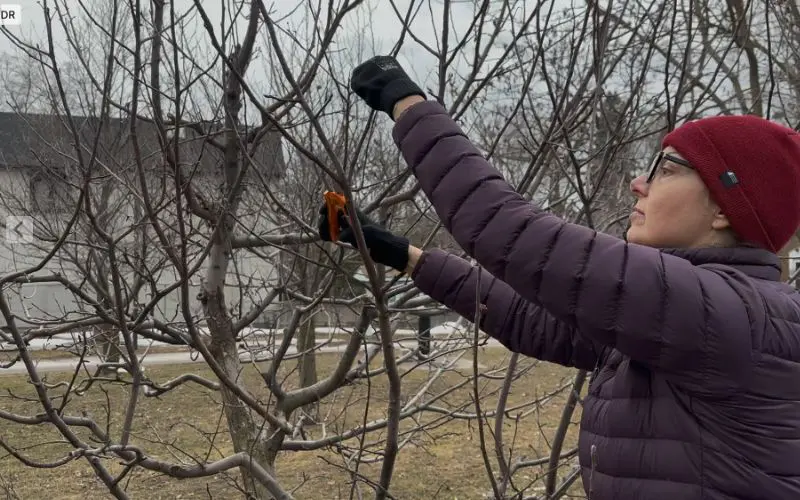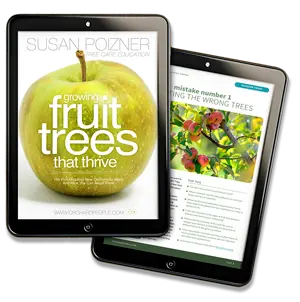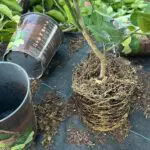How do you choose fruit trees that will work for your landscape? This article and video show you the tips Read more
When to Take Fruit Tree Cuttings: The Best Time to Collect and Store Scion Wood

If you’ve ever wanted to propagate your own fruit trees, you’re in for an exciting journey. One of the easiest and most reliable ways to grow new trees is using the simple art of fruit tree grafting, and to do that, you’ll need scion wood—cuttings taken from existing fruit trees. But when to take fruit tree cuttings is a crucial question. Let’s dig into the details.
When to Take Fruit Tree Cuttings for Best Results
The ideal time to take fruit tree cuttings depends on the type of tree. For apple and pear trees, which are among the easiest to graft, the best time to collect scion wood is during the dormant season—winter. When trees enter dormancy, they slow down all active growth, making this the perfect time to harvest strong, healthy cuttings.
Here in Toronto, that means early March. If you collect them too early in the winter, they’ll need careful storage for months, which increases the risk of drying out or developing mold. On the other hand, if you wait too long and the buds begin to swell, the wood may no longer be viable for grafting. Knowing when to take fruit tree cuttings can make all the difference in a successful grafting season.

You can also take cuttings from stone fruit trees like cherries, apricots, and peaches, but they are often propagated more successfully through budding rather than grafting. Budwood for summer budding is typically harvested in mid-to-late summer when the buds are fully developed but the tree is still actively growing.
As for citrus or tropical fruit trees, propagation techniques vary widely. Some tropical fruit trees may be propagated through cuttings, but the timing and success rates differ depending on the species. If you’re interested in propagating citrus or tropical fruit trees, it's best to research the specific tree species for the most effective propagation method.
How to Identify the Right Branches for Scion Wood
Not just any branch will do! To ensure successful grafting, you need to harvest new growth from the previous year.
Here’s how to identify the best scion wood:
- Look for pencil-thick branches—too thin, and they’ll be hard to graft; too thick, and they might not take well.
- Find the growth ring, which looks like a slight ridge or “wedding ring” on the branch. Everything beyond that point is the current year’s growth.
- The bark should be smooth and unblemished.
- Avoid branches with large flower buds—those are meant to produce fruit, not to be grafted.
Fruit Trees
That Thrive

A quick tip: As spring approaches, you might notice a silvery sheen on the terminal bud. That’s still a good time to collect cuttings, but once the buds start to swell and open, it’s too late for long-term storage. This is why understanding when to take fruit tree cuttings is essential for success. Learn more about that in the video below.
How to Store Scion Wood Properly
Once you’ve collected your cuttings, proper storage is key to keeping them in good shape (and alive!) until grafting season. Here’s my step-by-step process:

- Seal the cut ends: Melt candle wax using a candle warmer lamp (affiliate link) and dip the cut ends of each scion to seal in moisture.
- Bundle them up: Line up the cut ends and wrap them in painter’s tape, keeping each cultivar in a separate bundle.
- Label everything: Write the cultivar name and the collection date on the tape and on the newspaper wrapping.
- Moisten and wrap: Briefly dip the top and bottom of newspaper-wrapped bundles (ie the area where the cut ends of the branches are and the area where the branch tips/terminal buds are) in water to keep them hydrated, then place them in a sealed plastic bag.
- Cold storage: Store the bagged scion wood in a beer fridge or cold storage area—away from fresh fruits and vegetables!

Why no fresh produce? Fruits and veggies release ethylene gas, which can wake up your scion wood from dormancy too early, making it unusable for grafting. Keeping them stored correctly is just as important as knowing when to take fruit tree cuttings.
Checking Your Scion Wood Before Grafting
If you’re storing your cuttings for more than a few weeks, it’s a good idea to check on them regularly. Every week or so, open the bag and inspect the scions. Look for:
- Mold or mildew—If you spot any, wipe it off with a damp paper towel and ensure the scions aren’t too wet. Then wrap them up again in fresh newspaper and plastic.
- Drying out—If the wood looks shriveled, lightly mist the newspaper before sealing it back up.
- Green cambium—Scratch the bark slightly; if the tissue underneath is green, your scion is still alive and ready for grafting.
After checking the scions, reseal them up again in the bag.
This extra care ensures that the scion wood you worked so hard to collect is still viable when grafting season begins.
Ready to Graft? Here’s What’s Next
Once spring arrives and temperatures warm up, it’s time to graft your stored scion wood onto rootstock or existing trees. If you’re new to grafting or want to improve your skills, check out our in-depth guide: The Simple Art of Grafting Fruit Trees: A Complete Guide.
Want hands-on guidance? Our Complete Guide to Fruit Tree Grafting and Budding online course walks you through everything step-by-step.
Knowing when to take fruit tree cuttings is just the first step in growing healthy, thriving fruit trees. Happy grafting, and may your new trees flourish!

Susan Poizner
Learn more about Susan on the about us page.



